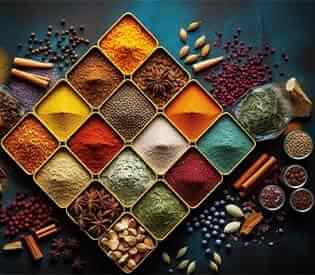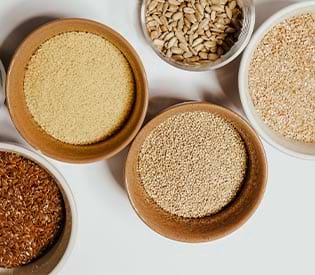Echinacea Powder
📦🚚 Fast & Free shipping on all orders
What is echinacea powder?
Echinacea purpurea is one of nine types of echinacea that grow in North America. People refer to it as a purple coneflower due to its purple flower petals and easily visible spiny seed head. Our echinacea powder is made from an echinacea plant that has been grown in a healthy way. The powder can be used in cooking, put into plant oils, tinctured, or put into capsules. For many years, traditional herbalists and Native Americans in North America frequently used echinacea. In the 1900s, echinacea started to become popular in Europe. In the past, people mostly used it topically, but one of its major uses is to help keep the immune system working well. It is now one of the most common nutrition products sold in health food shops, and scientists are still looking into how it can help the immune system.
Echinacea helps your immune system work well, so you can feel your best. Additionally, it supports the proper operation of your body's defenses, allowing you to feel well. Nine kinds of echinacea are native to the United States and southern Canada. Most of the population is in Kansas, Arkansas, Oklahoma, and Missouri. These plants are annual members of the sunflower family, or Asteraceae. They like rocky, disturbed soils in open fields, grasslands, and along train tracks. Most of the stuff that is sold is E. purpurea, E. angustifolia, and sometimes E. pallida. E. purpurea is a big, bushy shrub that grows 4-5 feet tall and has coneflowers that are bright purple, which is why it is called a "purple coneflower." The leaves are larger than those of E. angustifolia, which has more pointed, hairy leaves (the species name, "narrow-leaved," comes from this) and only gets to about a foot tall. People often mix up E. pallida and E. angustifolia because their light pink flowers and uses are similar. The name "Echinacea" comes from the Greek word "echinos," which means "hedgehog." This designation is because the seed head looks like a hedgehog.
Native Americans and traditional herbalists in the United States and Canada used echinacea a lot. A Louisiana horse rider was among the first to write about this herb. In 1914, Melvin Gilmore wrote Uses of Plants by the Indians of the Missouri River Region, which states that "echinacea seems to have been used to treat more illnesses than any other plant." This plant was essential to many groups, like the Pawnee, Dakota, and Omaha-Winnebago. People used it to treat everything from boils to diseased horses. People consumed this herb as a fresh drink, a herbal smudge, or as smoke. The leaf or root was also often just chewed on. In the past, people used echinacea to boost their defense system and also applied it to their skin.
In the late 1800s, Echinacea became famous in the United States because of the work of eclectic doctors who were especially interested in E. angustifolia. John Uri Lloyd and John King were big supporters of this herb. They discussed how great it was for many years, until it became the Eclectics' favorite plant. It was very popular until the Eclectic schools shut down in the mid-1930s. Thereafter, echinacea became less famous in the United States. Herbalists revived it in the 1970s after it had fallen out of favor. During this time, however, E. purpurea was becoming more well-known in Germany. Ironically, most traditional herbalists and Native Americans used E. angustifolia, but the Germans ended up studying E. purpurea, which is why it became the most famous species, first in Europe and then in the United States.
Therefore, the species that has the most historical evidence also has the least scientific research conducted on it. According to the story, Dr. Vogel, a Swiss homeopathic doctor, came to the United States in the 1950s to study Echinacea in South Dakota. He brought back what he thought were seeds from E. angustifolia and gave them to a German doctor. The doctor planted the seeds and made medicine from them. It soon became clear that the species was actually E. purpurea. This led to its widespread fame and extensive study in Europe. You can use the dried root to make tea, mix it with other herbs, or tincture it.
How do I use echinacea powder?
Daily, incorporate 1-2 teaspoons of the powder into food or beverages. Due to its root-like flavor, people frequently incorporate echinacea powder, sweetened to taste, into teas and other heated beverages. As a dietary supplement, the powder is an excellent addition to beverages and smoothies, as well as oatmeal and porridge.
Echinacea powder benefits:
People take echinacea to shorten the time they have a cold or the flu and to relieve symptoms like a sore throat, cough, and fever. Many herbalists also advise using echinacea to strengthen the immune system and aid the body in battling diseases.
◉ Helps Combat Cancer: The National Institutes of Health (NIH) has released some intriguing studies about the benefits of echinacea for brain cancer. Researchers say that "the medicinal value of phytochemicals found in Echinacea is clear" and that this shows that phytochemicals found in other flowers that haven't been found yet may also be useful tools for fighting cancer. Researchers now recommend using echinacea "alongside or even instead of conventional therapy" as an alternative cancer treatment method.
◉ Boosts the Immune System: How does echinacea help people who have a cold? The University of Connecticut used 14 different studies to do a meta-analysis on the benefits of echinacea. The results were published in the journal Lancet Infectious Diseases.
It was found out that
Echinacea can make it 58% less likely that you will get a typical cold.
Taking echinacea cuts the length of a cold by almost 1.5 days.
Craig Coleman, an assistant professor of pharmacy practice and the study's lead author, said, "The main thing to remember from our study is that echinacea really does help prevent and treat colds." Echinacea products are one of many successful ways to avoid and treat colds because of this. Dr. Coleman found that "the importance of this finding becomes clear when you think about the fact that Americans get a billion colds every year and spend about $1.5 billion on doctor visits and another $2 billion on over-the-counter cough and cold medicines."
◉ Functions as a Laxative: Like many herbs, echinacea is beneficial for the gut and the rest of the digestive system. Medical herbalism, for example, says that it can be used as a gentle cleanser to relieve congestion and as a relaxing agent. This works especially well when you drink the plant tea. One cup of tea a day can help loosen the bowels for long-term conditions. Two or three cups a day can help with rapid bouts. But don't use this plant too much if you want to avoid side effects. To be safe, don't drink more than two cups of tea a day and follow the directions on the labels of any vitamins you take.
◉ Acts as an Anti-Inflammatory Agent: Most illnesses start with inflammation. Stress, poisons in our food, and not getting enough sleep are all factors. The University of British Columbia says that taking echinacea on a daily basis can help prevent and relieve many types of inflammation. Products with echinacea in them might even help with uveitis, which is an infection of the eye. People with chronic inflammatory diseases like rheumatoid arthritis should drink green tea daily to lower inflammation throughout their bodies.
Where to buy Echinacea Powder?
Buy echinacea powder from the health food store in the USA, Alive Herbals.
Echinacea Powder information (at a glance):
| Product Name | Echinacea Powder. |
| Scientific Name | Echinacea purpurea (Asteraceae). |
| Country of Origin | It is native to Germany, United States. |
| Ingredient | Echinacea Powder. |
| Taste & Aroma | Aroma: Aromatic. Taste: Bitter, numbing. |
| Shelf Life & Storage | Shelf life is about 6–18 months. Store it in an airtight container in a cool, dry place and prevent sunlight exposure. |
| Precautions | We requested you, Before consuming spices, herbs, teas or any kind of natural products you consult an expert qualified healthcare practitioner or herbalist. |
| Note | This product information has not been appraised by the Food and Drug Administration (FDA). This information is solely intended for educational purposes. |







